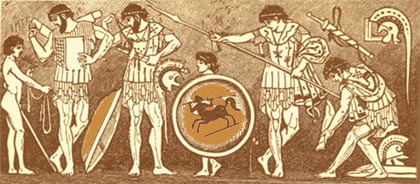
Just before Christmas, Martin came over to my house for a game of Sword & Spear. I recently bought these rules and really liked them (and also posted a first impressions piece here on the blog), so I was aching to try them out. I was also desperate to get my 6mm Greeks on the table, so this time it was really a “kill two birds (or perhaps Greeks) with one stone” kind of thing.
Consequently, this post will be both an AAR and some general reflections about the rules and how they work.
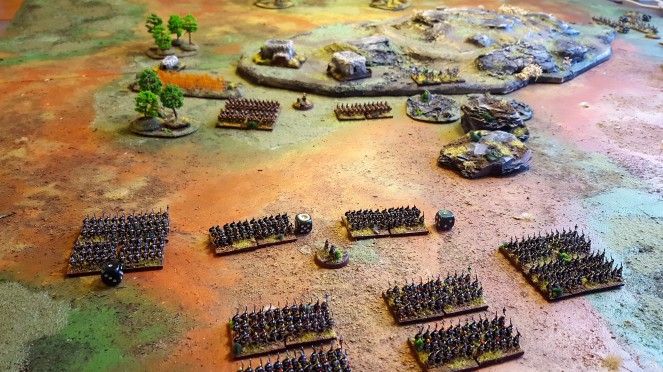 We played a home brewed scenario where the outskirts of a small village in the Peloponnese is attacked by Athenian forces (in the foreground). Only two units of Spartan Hoplites, plus one unit of Helot Psiloi, is present in the village at the start of the game.
We played a home brewed scenario where the outskirts of a small village in the Peloponnese is attacked by Athenian forces (in the foreground). Only two units of Spartan Hoplites, plus one unit of Helot Psiloi, is present in the village at the start of the game.
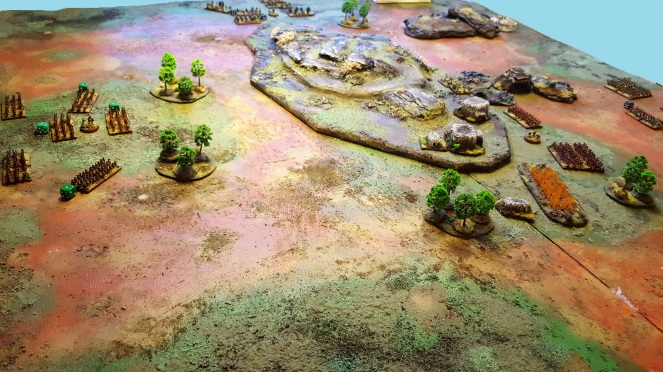 Spartan reinforcements are arriving from the opposite table edge (to the left in this picture), but they have to cross through forests and hills, and may also be intercepted by Athenian Light Cavalry and Peltasts (visible in the top end of the picture).
Spartan reinforcements are arriving from the opposite table edge (to the left in this picture), but they have to cross through forests and hills, and may also be intercepted by Athenian Light Cavalry and Peltasts (visible in the top end of the picture).
The Athenians want to “ravage the land”, as Thukydides would have described it: burn the granaries down and set fire to the nearby wheat field. The Spartans obviously don’t want that to happen.
*
Sword & Spear uses a very interesting unit activation system, based on the allocation of action dice. Each player has a set number of dice (preferably distinguished from the other player’s dice by color), equal to the amount of units he’s fielding. In this case, the Spartans began the game with nine units, and the Athenians with fourteen. As battles are fought and units rout, action dice are removed from the pool, meaning that you generally have less and less options available as the game progresses.
The game turn is divided into phases. In each phase seven dice are picked randomly from a bag and distributed to their respective players, who then rolls them. The player with the highest amount of dice in any given phase is the active player, and allocates his dice first. Units are then activated in sequence, depending on their dice number.
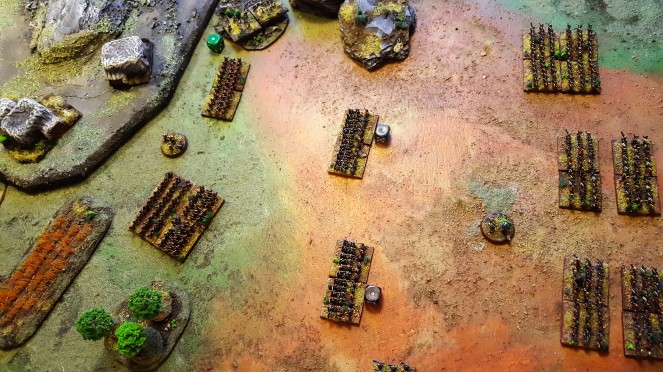 In this game the Athenians obviously tended to be active more often, at least in the beginning. Here their Hoplites advance towards the village, trying to draw the Spartans out.
In this game the Athenians obviously tended to be active more often, at least in the beginning. Here their Hoplites advance towards the village, trying to draw the Spartans out.
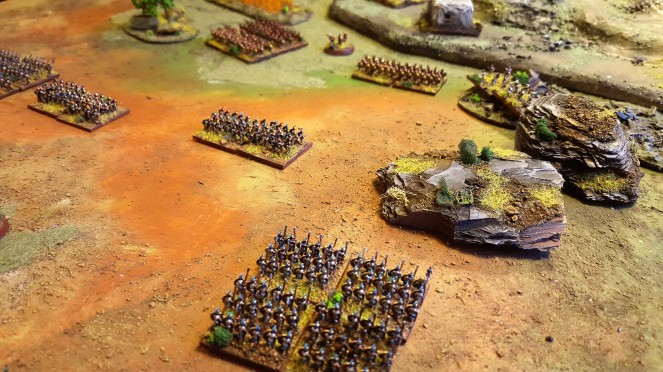 They also want to get this block of poor-quality Auxilia Troops into a flanking position, but that is hard to achieve because of those impassable cliffs.
They also want to get this block of poor-quality Auxilia Troops into a flanking position, but that is hard to achieve because of those impassable cliffs.
In Sword & Spear, each unit can only be activated once per turn, and only by an action dice equal to or higher than its Discipline Value. To perform anything more complex than a straight advance, a higher value is needed – and if the unit is large, as in this case, that value need to exceed the DV by two. Which means that this massive block of untrained troops needs a 6 to wheel around that rock, for example.
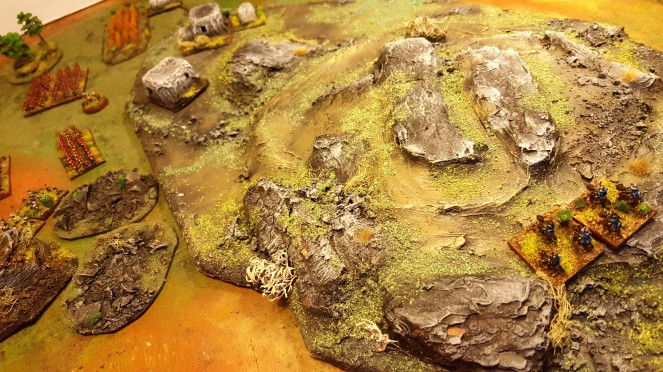 And as most of us know, sixes are sometimes very hard to come by. So unless you’re incredibly lucky you’ll need to prioritize and manage your resources carefully throughout the turn. Here the Athenians move their super-light Thessalian Cavalry over the hill in an attempt to reach the village quickly…
And as most of us know, sixes are sometimes very hard to come by. So unless you’re incredibly lucky you’ll need to prioritize and manage your resources carefully throughout the turn. Here the Athenians move their super-light Thessalian Cavalry over the hill in an attempt to reach the village quickly…
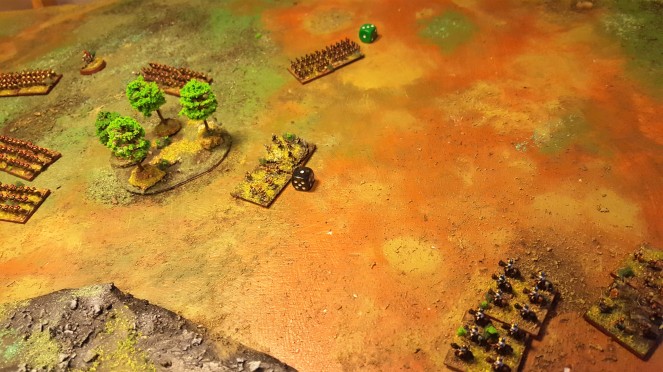 …while the Peltasts and Citizen Cavalry spread out towards the right, to harass and waylay the Spartan reinforcements.
…while the Peltasts and Citizen Cavalry spread out towards the right, to harass and waylay the Spartan reinforcements.
We quickly discovered that the unit movement speed should be slightly adjusted for smaller scales; as its stands, a Distance Unit (DU) is half of a unit’s frontage – in this case 3cm. Since most infantry units move 2-3 DUs per turn at the most, this makes for a pretty slow game as soon as anything needs to make its way across the board.
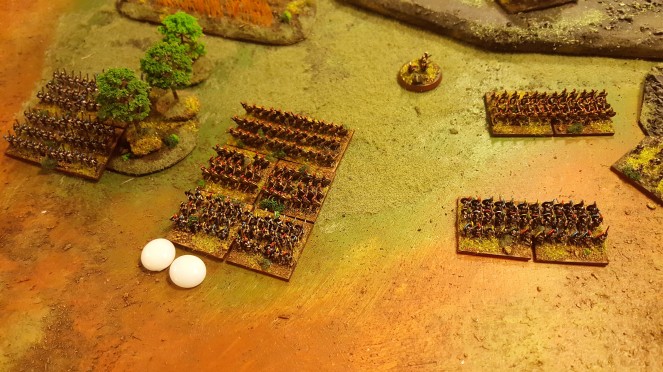 But now things finally starts happening on the opposite side of the battlefield, as the Athenians clash with a big block of Spartan Hoplites. Meanwhile, an Athenian Auxilia unit marches straight for the wheat field.
But now things finally starts happening on the opposite side of the battlefield, as the Athenians clash with a big block of Spartan Hoplites. Meanwhile, an Athenian Auxilia unit marches straight for the wheat field.
Combat in Sword & Spear is straightforward and pretty unforgiving; both sides roll a number of dice equal to their Strength Value (usually somewhere between 2-4) and match them off against each other, adding charge bonuses and other modifiers. The SV also equals the number of hits a unit can take before it breaks. Discipline tests are only used in conjunction with combat (basically a re-roll), so there are no separate morale checks or armor saves. A unit can only be rallied by attaching a general – a both risky and uncertain affair.
 The Thessalians have crossed the hill and close in on the granaries. But the reinforcements are now arriving at speed, helped by their superior discipline and some good dice rolls (the “1” dice in the picture only represent that the unit in question has activated this turn).
The Thessalians have crossed the hill and close in on the granaries. But the reinforcements are now arriving at speed, helped by their superior discipline and some good dice rolls (the “1” dice in the picture only represent that the unit in question has activated this turn).
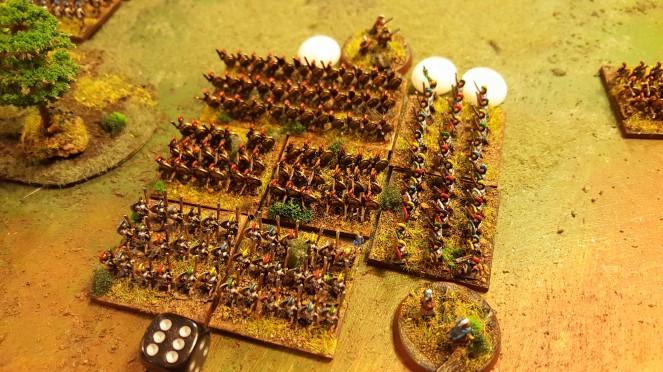 Good dice rolls are also frequent on the Athenian side this turn, aiding them against that monster block of Spartans (sixes gives bonuses in combat).
Good dice rolls are also frequent on the Athenian side this turn, aiding them against that monster block of Spartans (sixes gives bonuses in combat).
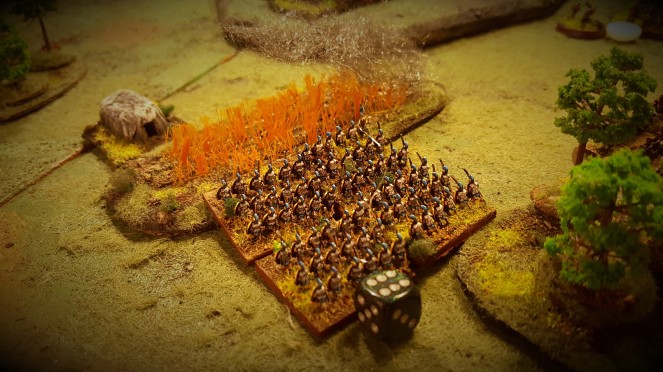 They also manage to set fire to the wheat fields.
They also manage to set fire to the wheat fields.
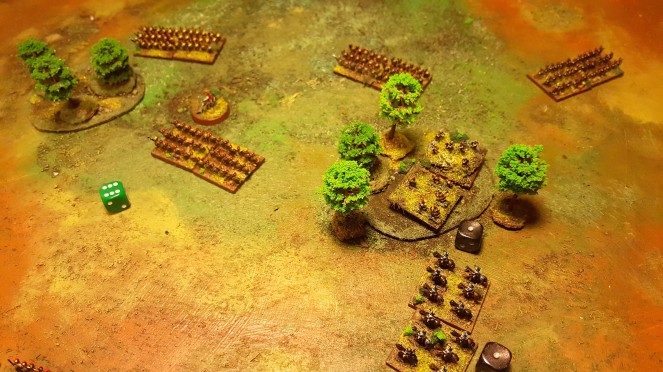 Several of the reinforcement units get stuck on skirmishers in the woodlands…
Several of the reinforcement units get stuck on skirmishers in the woodlands…
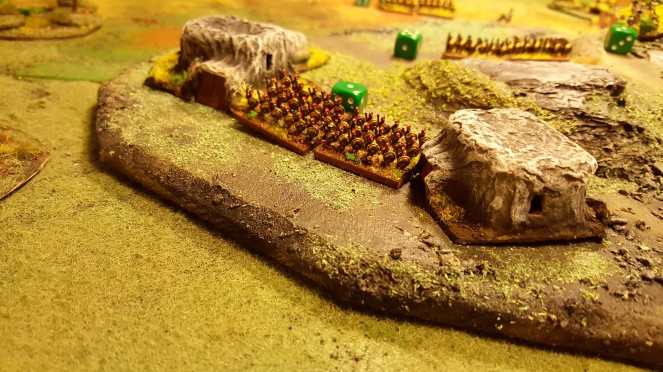 …but those who did manage to reach the village slaughter the Thessalians and then take up position between the granaries.
…but those who did manage to reach the village slaughter the Thessalians and then take up position between the granaries.
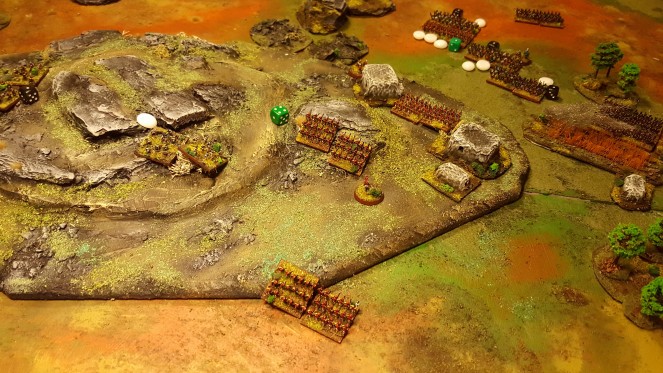 More reinforcements arrive, just as the Athenians defeat the remains of the defenders and position themselves for a final onslaught.
More reinforcements arrive, just as the Athenians defeat the remains of the defenders and position themselves for a final onslaught.
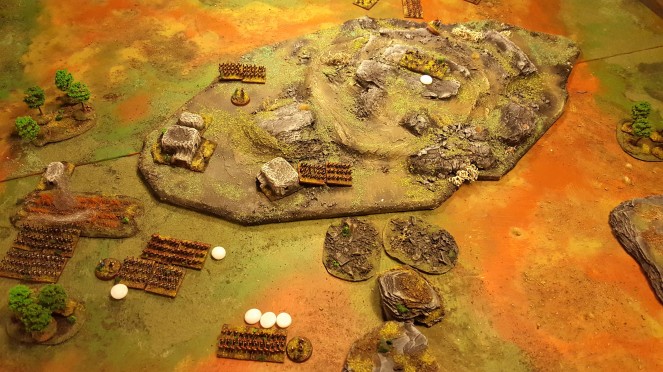 Now the Spartan troops’ superior quality really shine, as their fresh units rapidly manage to kill off the wounded and battle-weary Athenians. This reduces the number of Athenian action dice, but also counts towards army demoralization: each unit has an Army Value, which is added up to calculate the total Army Value for that army. When the army has suffered casualties equal to a third of its total AV, a discipline test is made for each unit.
Now the Spartan troops’ superior quality really shine, as their fresh units rapidly manage to kill off the wounded and battle-weary Athenians. This reduces the number of Athenian action dice, but also counts towards army demoralization: each unit has an Army Value, which is added up to calculate the total Army Value for that army. When the army has suffered casualties equal to a third of its total AV, a discipline test is made for each unit.
This is what happened at this stage in the game. The result was that several more Athenian units routed, which in turn meant that their casualties exceeded half of their total AV – they were effectively demoralized and the game ended with a Spartan victory.

Overall, it was an intense and fun game. Sword & Spear’s unit activation system makes for a dynamic and unpredictable experience, as you’re constantly having to manage your dice and consider not only which units should be activated, but also when and where. And since your opponent has the same woes and you’re constantly trying to outmaneuver each other, the whole affair is very different from the standard IGOUGO formula.
The combat system is quick and easy without being simplified; there’s no record keeping except for wounds (which rarely exceeds three anyway) and hardly any tables or lists to keep track of. And this goes for the game in general: as soon as you get a hang of the core rules you’ll only need the quick reference sheet.
*
Of course, there are some minor issues as well. First off: the heavy use of dice on the table will not appeal to all players. From a purely technical point of view it’s absolutely brilliant, but it does clutter up the board a bit and makes the game less pretty to look at.
Also, it requires strict organization and discipline. You need to make sure that all dice are showing the correct number at all times, that no dice are mixed up between units or phases, that the dice pool and the “discard pool” (basically, ones and twos that are useless during the turn) are kept separate, that the combat dice are not mixed up with the activation dice and that the dice removed from play due to casualties are showing the correct Army Value.
We were aware of this and did our best to keep track of everything, but still managed to get confused from time to time. There are so many different types of dice involved that you’ll probably need to use different sets (for combat and for activation, for example). And if you’re the “dice spreading” kind of guy, Sword & Spear is probably not for you as you’ll inevitably end up constantly trying to figure out which dice are which.
Another issue is rules ambiguity. Overall the text is crisp and clear, but there are some passages that could have used harsher editing. I’m mainly referring to how the more advanced aspects of combat are explained; impetus, extra dice, and so on. Perhaps this will become clearer after having played the game more, but we both felt that some things could be explained better.
Another annoying thing is that lines of text are actually missing in certain places, which can only be described as a sloppy editing. Perhaps understandable in a self-published book, but not acceptable at all in a product like this. Luckily though, no crucial stuff is missing.
On a side note, both Martin and I got the feeling that the game is not optimal for this type of maneuver-heavy scenario; it seems to be more aimed at pitched battles and lines of infantry advancing towards each other. So next time I’ll probably go for a more classic setup and avoid heavy use of terrain and the need for complex maneuvers.
*
But as I’ve already said: I really like this ruleset and look forward to playing it more. So stay tuned for upcoming AARs and more thoughts about how the system works for different scales and setups!

https://www.facebook.com/groups/173753339627986/173753342961319/?comment_id=173754446294542¬if_t=group_comment
LikeLike
Nice, thanks for sharing!
LikeLike
If your using 3cm Distance Units I would drop the table size to 5 foot wide x 3 foot deep.
LikeLike
Yup, will use a smaller table next time – alternatively measure DUs in inches instead.
LikeLike
Great AAR! Sounds like a very interesting game.
LikeLike
Ooops! Forgot to write that the game looks excellent with all those tiny Greeks.
LikeLike
Thanks Jonas! Bringing them to club as soon as I get back to town. : )
LikeLike
Thanks for this. Would appreciate you including the army lists used in future reports.
LikeLike
Sure thing!
For this game the army composition was as follows:
Spartans:
7 units of Spartan Hoplites
1 large unit of Spartan Hoplites
1 unit of Psiloi
Athenians:
6 units of Hoplites
2 large units of poor quality Hoplites
4 units of Peltasts
1 unit of Thessalian Cavalry
1 unit of Citizen Cavalry
The idea was that the Spartans should have better but fewer troops. Balance-wise I think the whole thing worked out pretty well, both because the Spartans had to march across the board to get their major force into play but also because the Athenians was active more often in the beginning but only had access to inferior units.
LikeLike
Hi Gunnar, this is Mark from the club. I have a question about the rules, do they cover Vikings as well as Normans and Saxons?
Great looking battle! I like the 6mm for big battles. I am working on more US Civil War 6mm Union miniatures this weekend.
LikeLike
Hi Mark!
The rules themselves will work well for anything between 3000 BC up to the late medieval period. Most major Dark Ages armies are covered in the free army lists available at the authors site:
http://polkovnik.moonfruit.com/sword-spear-army-lists/4584877293
Thanks for the compliment btw. I agree that 6mm is awesome for mass battles and intend to expand my collection of really, really small men soon (I’ll probably go for Persians this time). Best of luck with your ACW project, hope to see it at club some time! 🙂
LikeLike
Hi!
I have played Sword & Spear quite many times now and I have mended the rules for special scenarios and even pitched battles where units can march and activate a bit easier if they are outside 8 DU from any enemy units. All units activate with -1 discipline and if they manage a manoeuvre they can instead make an advance at +1 DU. If at any point a unit get within 8 DU from an enemy unit they loose this extra DU of movement in that movement. No unit may activate on “1” rolled on the activation dice.
This, in my opinion, is quite realistic and make the game work a bit better in certain types of scenarios and using things like flank marches.
You could try this if you ever play the game again, works really well. Personally I like S&S for both ancient, medieval and fantasy settings as it model command & control and FOW really well.
LikeLike